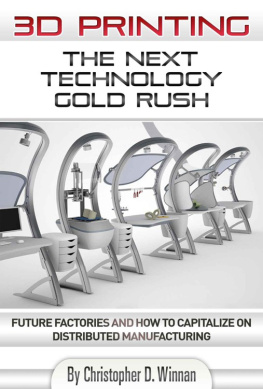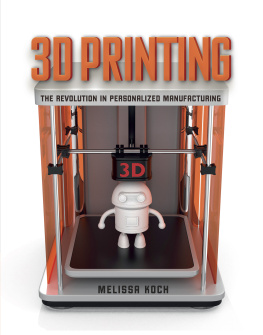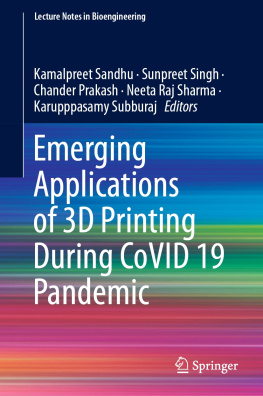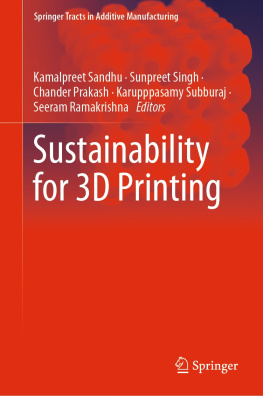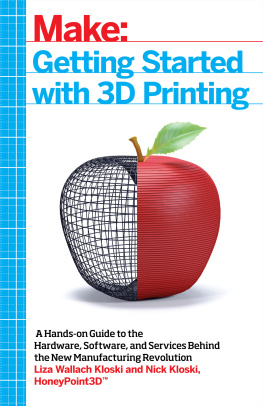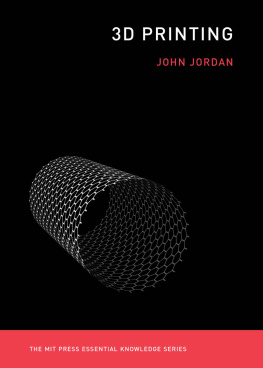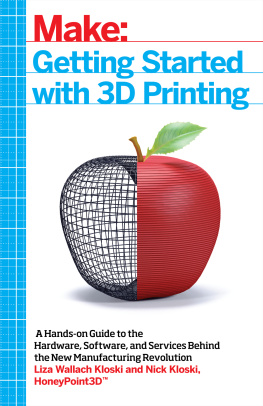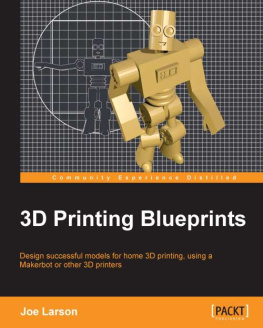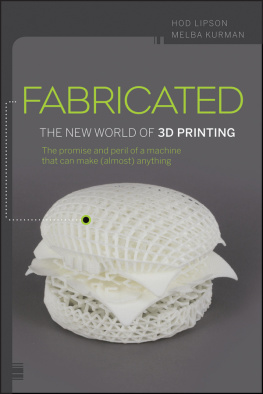3D Printers - The Next Technology Goldrush
By Christopher D. Winnan
Table of Contents
Copyright 2012 Christopher D. Winnan
All Rights Reserved
No part of this publication may be reproduced, stored in a retrieval system or transmitted, in any form or by any means, electronic, mechanical, photocopying, recording or otherwise, without proper written permission from the author. The only exception is a reviewer. A reviewer may quote brief passages in a review.
Acknowledgements
Thanks to Kevin Hayward for his much needed editing skills and the section on Legal Issues. Thanks also to Hannah Jones for her excellent proofreading skills and to Karick (Karen Reynolds-James) for her tireless formatting abilities.
Thanks also to all that was kind enough to allow me to link to their images, especially Tomasz Orzechowski, Co-Founder & Industrial Designer of TO DO Product Design (http://to-do.com.pl/index.html) of whose design of a twenty century modeler work station graces the front cover
Introduction

History repeats itself?
http://meerface.com/2012/01/3d-manufacturing-at-home/
If you are reading this, you already know that 3D printers are bringing about a revolution in manufacturing. Much like the industrial and computer revolutions, these amazing new machines will completely transform the face of manufacturing, distribution and consumption. But, for the moment, that is all just rhetoric, until current printer owners get up, lead the way and show where all the profits lie. Resolutions are improving and costs are decreasing all the time. Did you know for example, that 3D printing was used to create the suits of armour in Iron Man and the Aston Martins in the latest Bond movie? Even so, some people worry that we are still in the 'spend a lot or be disappointed' early-adopter stage. The real question that most people want answered is this: Can I make a buck from these machines? and the answer is a resounding yes, not only a buck, but probably a couple of hundred bucks a day and maybe even a lot more. This exciting new technology is destined to provide all kinds of exciting new opportunities and employment.
If you have an interest in 3D printers at the moment, then you should be looking at yourself as the twenty-first-century counterpart of pioneers like Bill Gates and Steve Jobs, from the early computer home-brew clubs. It was guys like these who first thought about how to monetize this technology, and went on to be the earliest IT billionaires. If 3D printers really are the beginning of a game-changing new technology, then there are going to be plenty of billionaires made on the way, maybe even the world's first trillionaire, who knows?
3D printing is a technology on the cusp, and therefore it is essential that you be fully prepared for its arrival. The only way to profit from great changes is to anticipate them in the very early stages, and be ready to take advantage of the opportunities that they create. We are still at the beginning phase today, but major technical advances are already heralding enormous business opportunities. This book is not just idle speculation. The material here has been meticulously researched and combined with a uniquely specialised knowledge of overseas manufacturing, niche markets and emerging economies. I was lucky enough to spend much of the nineties in Seoul, observing the largest of the Asian Tigers transform itself into an industrial powerhouse. The following decade was spent in the Peoples' Republic of China, observing the dragon wake from it centuries of slumber. Most recently, I have been on numerous trips to Myanmar, exploring the key strategic regions of the Burma Road and the Indian Gulf. As a well-established guide book writer, I am in a very good position to document these areas, opening up paths for other entrepreneurs and investors to follow. In this book I will be focussing not on one particular geographical area, but one specific technology, that of additive manufacturing, better known as 3D printing.
Since the 3D printer patents expired in 2009, I have been watching this field with great interest. Home-brew tinkerers and hacker-space gizmologists have quietly been bringing the designs and capabilities of these amazing new machines up to a level where they are almost ready to hit the mainstream. Back in the seventies, it took more than five years before personal computers found their first killer app, and another ten years before they were able to crack the home market. Kurzweil's law of accelerating returns demonstrates very clearly that the coming paradigm shift to digital manufacturing will take place even faster than the seismic events of the previous digital revolution. The average Joe still has only a very vague idea of what 3D printing actually is, let alone its capabilities, its financial applications and its massive game changing potential. If you want to play a role in the next industrial revolution, you will need to be a good three steps ahead of everybody else, who are just now waking up and paying attention to what 3D printing is all about.
This book is much more than a brainstorming of random ideas that might eventually come into effect sometime in the next decade. I have actively tried to steer clear of all the usual type of fantasy, tea-leaf predictions, 'move into toilet paper and become a billionaire' thinking. This book is about opportunities and markets that exist right now. This is not some cyberpunk fantasy of vague speculation, but a detailed overview of everything that is relevant and important in the 3D printing industry. Even now, this is a vast field, with new changes taking place every single day. It will undoubtedly affect many areas of our everyday lives with accordingly immense social impacts. This book shows you how to successfully anticipate these developments, and how to surf the crest of this technological tsunami, while everybody else is swallowed up and swept away.
At the same time, this book is not a specialist MBA in digital entrepreneurship. I have researched and presented the most relevant material available, but at the same time this is not a book about niche marketing or online business. I have obviously touched on these areas, as they will undoubtedly play an important role, but this is not a dummies guide to setting up a 3D printing business in the age of the internet. There are plenty of books out there about online selling and internet marketing. If you are savvy enough to see that another industrial revolution is about to take place, then it is also a fair bet that you already know how to make tools like eBay, Etsy and Facebook work for you. To this end, I am happy to share with you as much as I currently know about the current state of digital manufacturing, but I will not be teaching you how to suck eggs.
While there are already hundreds, if not thousands of books out there on starting and running a successful internet business, this book is something else completely. This is a collection of cutting-edge knowledge that has not yet been compiled elsewhere. In fact, parts of it are so specialised, that you would be hard pushed to find large chunks of it just about anywhere. Despite their explosive implications, few people are writing in any detail about the digital rights management of physical objects, or the enormous varieties of scale in the miniatures market, or state of the art advances in mixed-mesh modelling. Few apart from the most avid collectors appreciate the field of 1/6 scale military figures as an emerging art form, or the industrial applications of complex geometries and spiral vortices, or even the rapid miniaturisation that is taking place in the arena of autonomous robotics. All of these subjects are covered here, clearly explaining their close relationships with 3D printing.
Next page
